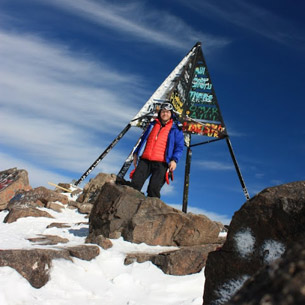In December 2010, after spending the past 4 years preparing and working on various expeditions, I found myself with the luxury of a 1 week holiday? I browsed the website of low-cost airliner and started looking for good deals and inspiring places. Cyprus? Malta? The winner was Marrakech as I had never been to Africa except for a day in Tanger after crossing Gibraltar. I was excited by my choice as I would be in a warm place while the snow had started to cover Europe. Visiting a cultural and famous city, eating local dishes and getting lost in the Souk and the myriad of colors. I opened an atlas and my eyes went straight on the Atlas Mountains, actually it was even the High Atlas. And there it was, Mount Jbel Toubkal, the highest summit of Northern Africa at 4.167m, a little challenge. It took me just a week to prepare the climb and estimate the trek around the Mountain was possible too in a few days. I found people who combined the trek and the climb in 6 days but I must do faster to catch my plane back.
I packed all my lightest and most efficient gear into a cabin-sized backpack and arrived at night in Marrakech. I roamed the Jamaa el-fnaa plaza and found a room to sleep. In the airline cabin, crampons, ice-axe, tent stakes and gas stove are prohibited and I needed to find solutions to get that gear as the mountains are covered with snow. On the plaza, I find bamboo sticks and plastic bags, from which I build my trekking poles that can double as tent stakes. After a good sleep in my hostel, I get the last food and take a taxi to Imlil, one of the entrance villages to the High Atlas. I find Mustapha, a guide who rents me a pair of crampons; we share some stories about the mountains and, of course, hot tea.
It’s already late in the afternoon and I have to rush to reach the Toubkal refuge 1500m higher. Underway I meet a few people with donkeys, climbers, I’m in Berber country and I do not speak the language. My pace is slow and I start to feel the altitude around 2500m where it begins to snow and the sun begins setting. About an hour from the refuge, it’s dark and I do not want to use the batteries of my head torch. It’s slippery but ok to guess the route safely. I soon see a light in the distance and reach the hut happy, cold and hungry. I have to learn the lesson that night comes quickly in the winter and the cold is permanent in these mountains. I pitch my tent and get warm water. There are four Spaniards who intend to wake up early to climb the peak before the morning clouds hide the view from the summit. I will follow the same idea.


















